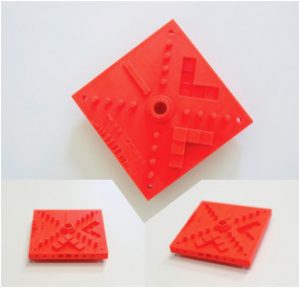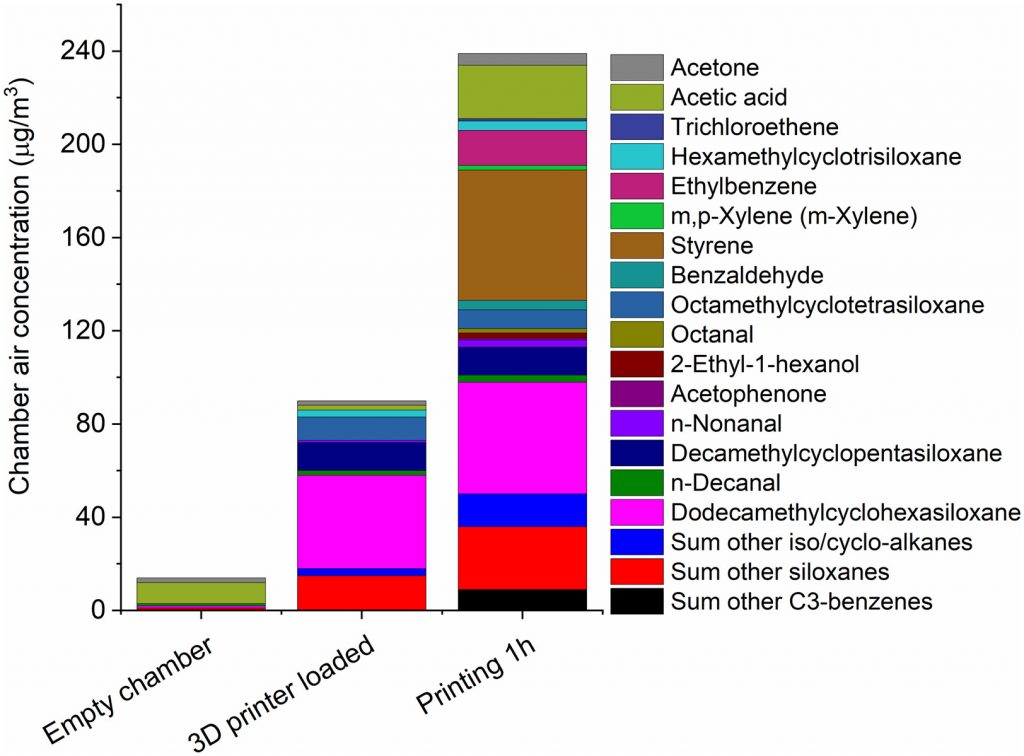3D printing, for all of its multitudes of benefits, also comes with some risks, which include the emission of ultrafine particles and gaseous pollutants. In a paper entitled “Characterization of particulate and gaseous pollutants emitted during operation of a desktop 3D printer,” a team of researchers tests eight different kinds of 3D printer filament for ultrafine particles and volatile organic compounds. All experiments were carried out on a Zortrax M200 3D printer, which has a single extruder, single heated plate, and sidewalls but no cover on the top. They tested ABS, ULTRAT, ASA, HIPS, PETG, GLASS (PETG mixed with fiber glass filings), PCABS and ESD.
 The researchers 3D printed a small model that has been proposed by the National Institute for Standards and Technology (NIST). It consists of a square base and several small structures on the top and one side wall. The 3D printing was carried out in a stainless steel chamber with air set to 50% relative humidity and 23ºC. Air samples were taken to determine the chamber’s background concentrations of volatile organic compounds (VOCs) and very volatile organic compounds (VVOCs). The 3D printer was loaded into the chamber, and samples were taken again one hour after loading.
The researchers 3D printed a small model that has been proposed by the National Institute for Standards and Technology (NIST). It consists of a square base and several small structures on the top and one side wall. The 3D printing was carried out in a stainless steel chamber with air set to 50% relative humidity and 23ºC. Air samples were taken to determine the chamber’s background concentrations of volatile organic compounds (VOCs) and very volatile organic compounds (VVOCs). The 3D printer was loaded into the chamber, and samples were taken again one hour after loading.
Once the 3D printing started, the particle filter sampling started and continued until the printing was finished. VOCs were sampled one and two hours after the printing started, and VVOCs were sampled an hour and a half into the printing process. A single test was performed for each type of filament, except for ABS, for which different filament colors and printing temperatures were also tested. Each 3D printing job lasted for about four hours.
“High particle SERs were found during printing with ASA (blue), ULTRAT (ivory), ESD (black) and PCABS (ivory),” the researchers state. “Printing with GLASS (transparent), HIPS (yellow), and PETG (black) was associated with lower particle SERs. The particle emissions for the ABS_Red filament were evaluated under different printing temperatures. In addition to the default printing temperature of 275 °C for ABS, we measured particle emission at four different temperatures of 230 °C, 240 °C, 250 °C and 260 °C, respectively. Particle SERs for ABS decreased with lower extruding temperatures from 260 to 230 °C.”
The VOCs detected during the tests included caprolactam, 4-tert-butylphenol, 2,4-di-tert-butylphenol and DEP. They also detected several semi-volatile organic compounds, or SVOCs. Styrene was the major VOC, follwoed by other substances including benzaldehyde and ethylbenzene. Only a few VVOCs, including acetaldehyde, 2-propanol, acrylonitrile and alcohol were detected at low concentrations.
“To the best of our knowledge, we have demonstrated for the first time that the particles emitted from a desktop 3D printer are semi-volatile and are composed of SVOCs which are mainly thermoplastic additives and cyclosiloxanes,” the researchers conclude. “Our data, which supplement results from previous studies, lead to the conclusion that, regarding particulate and gaseous emissions, 3D printing technology and the chemical composition of filaments still need to be optimized.”
As the researchers pointed out, other studies have also measured the emissions given off by 3D printers, although most studies have focused on ABS and PLA rather than such a wide variety of materials. All of the studies point to the same conclusion – 3D printing is far from ideal when it comes to emissions, and steps need to be taken to minimize these chemicals and make the technology safer.
Authors of the paper include Jianwei Gu, Michael Wensing, Erik Uhde and Tunga Salthammer.
Discuss this and other 3D printing topics at 3DPrintBoard.com or share your thoughts below.
Subscribe to Our Email Newsletter
Stay up-to-date on all the latest news from the 3D printing industry and receive information and offers from third party vendors.
You May Also Like
3DPOD Episode 198: High Speed Sintering with Neil Hopkinson, VP of AM at Stratasys
Neil Hopkinson, a pioneering 3D printing researcher, played a pivotal role in developing a body of research that is widely utilized today. He also invented High Speed Sintering (HSS), also...
GE Additive Transforms into Colibrium Additive in New Brand Move
One of the largest and most compelling companies in the 3D printing industry, GE Additive, has undergone a rebrand. Now, known as Colibrium Additive, the company and its new name...
HP & INDO-MIM Collaborate to Boost Metal 3D Printing in India
HP Inc. and INDO-MIM, a US- and India-based supplier of metal injection molding (MIM) powders and contract manufacturer, have announced that the two companies will collaborate to accelerate additive manufacturing...
Nylon 3D Printed Parts Made More Functional with Coatings & Colors
Parts 3D printed from polyamide (PA, Nylon) 12 using powder bed fusion (PBF) are a mainstay in the additive manufacturing (AM) industry. While post-finishing processes have improved the porosity of...

































